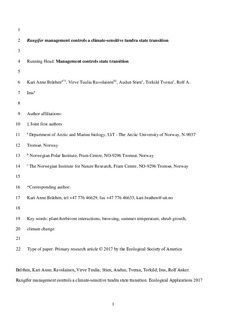| dc.description.abstract | Rangifer (caribou/reindeer) management has been suggested to mitigate the temperature- driven transition of Arctic tundra into a shrubland state, yet how this happens is uncertain. Here we study this much focused ecosystem state transition in riparian areas, where palatable willows (Salix) are dominant tall shrubs and highly responsive to climate change. For the state transition to take place, small life stages must become tall and abundant. Therefore we predicted that the performance of small life stages (potential recruits) of the tall shrubs were instrumental to the focal transition, where Rangifer managed at high population density would keep the small-stage shrubs in a “browse trap” independent of summer temperature. We used a large-scale quasi-experimental study design that included real management units that spanned a wide range of Rangifer population densities and summer temperatures in order to assess the relative importance of these two driving variables. Ground surveys provided data on density and height of the small shrub life stages, while the distributional limit (shrubline) of established shrublands (the tall shrub life stage) was derived from aerial photographs. Where Rangifer densities were above a threshold of approximately 5 animals/km2, we found, in accordance with the expectation of a “browse trap,” that the small life stages of shrubs in grasslands were at low height and low abundance. At Rangifer densities below this threshold, the small life stages of shrubs were taller and more abundant indicating Rangifer were no longer in control of the grassland state. For the established shrubland state, we found that the shrubline was at a 100- m lower elevation in the management units where Rangifer had been browsing in summer as opposed to the migratory ranges with no browsing in summer. In both seasonal ranges, the shrubline increased 100 m per 1°C increment in temperature. Our study supports the proposal that Rangifer management within a sustainable range of animal densities can mitigate the much-focused transition from grassland to shrubland in a warming Arctic. browse trap; browsing; climate change; life history stage; plant–herbivore interactions; Salix; shrub growth; shrubline; summer temperature. | nb_NO |
